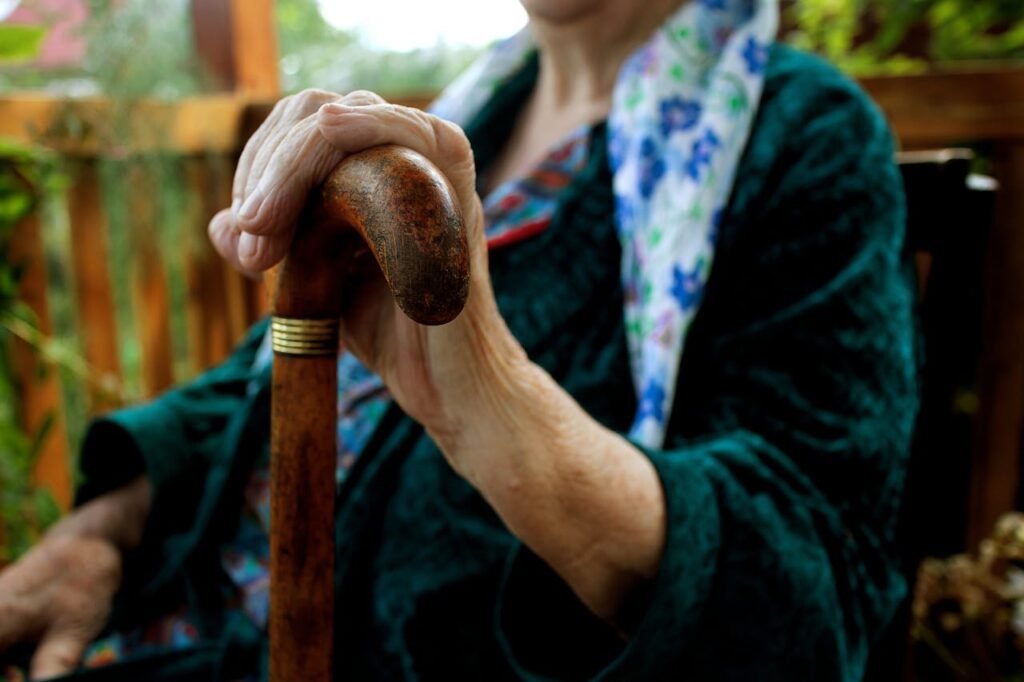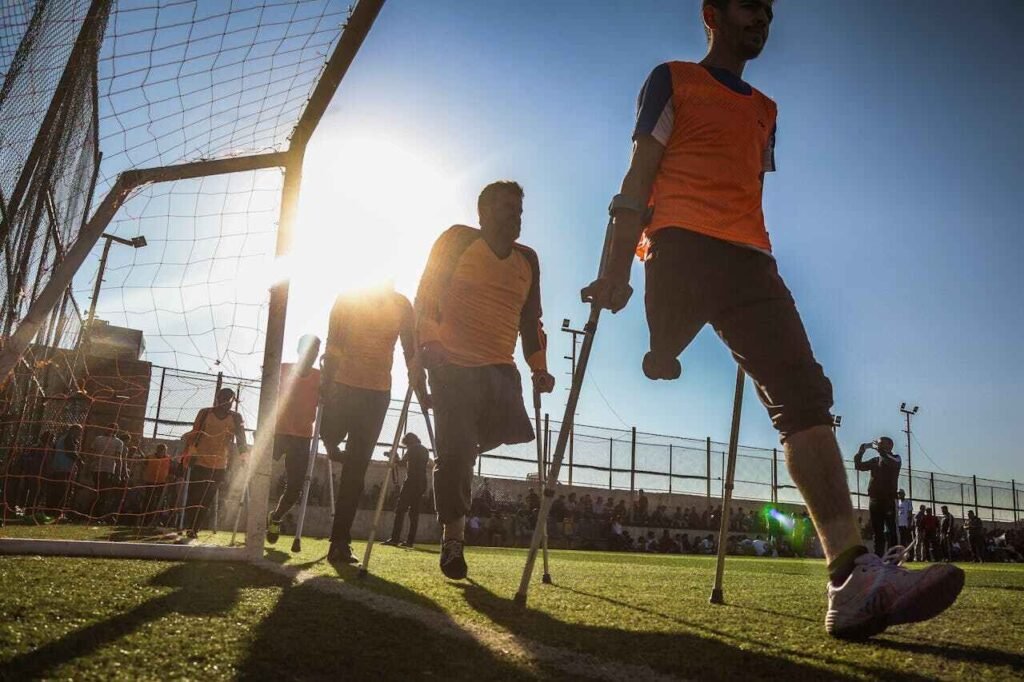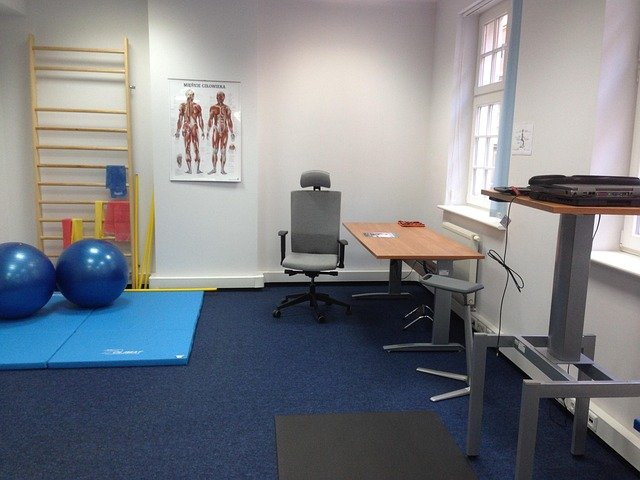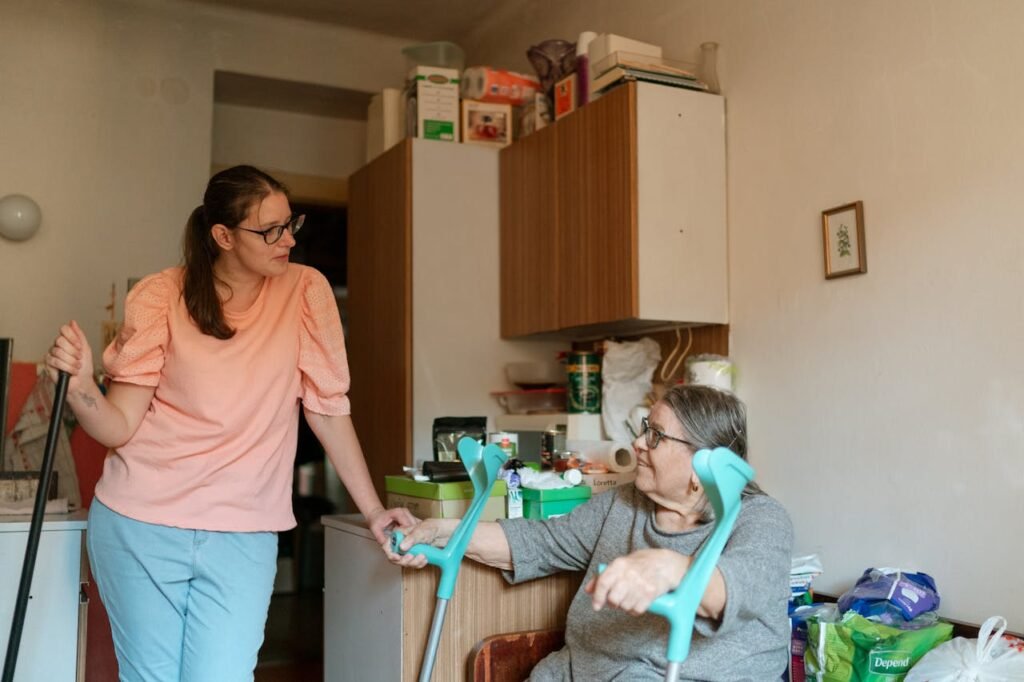Walking should feel natural, steady, and peaceful. But after losing a limb, taking those first few steps again can bring mixed emotions—hope, fear, and a quiet wish to feel normal once more. For many seniors or new prosthetic users, this journey begins not with independence but with support: a cane, a walker, and the courage to trust your prosthetic leg.
At RoboBionics, we meet hundreds of individuals across India who want one thing above all—confidence while walking. The coordination between your assistive device and your prosthesis is the bridge that gets you there. When they work together, you move smoothly, stand taller, and regain the freedom to go wherever life leads you.
This article is a complete guide to mastering that coordination. You’ll learn how to use a cane or walker safely, train your body to move in rhythm with your prosthesis, and slowly regain the balance and confidence to walk freely again. The steps are simple, the tone is calm, and the goal is clear—to help you feel sure on your feet, one stride at a time.
Understanding Assistive Walking Devices
Why Walking Support Matters

Using a cane or walker alongside a prosthetic leg is not a sign of weakness—it’s a tool for strength and safety. These devices help your body relearn movement patterns after limb loss, especially when your balance or endurance is still improving.
They allow your body time to adjust to weight shifts and ground feel. Instead of worrying about falling, you can focus on rhythm, control, and confidence with every step.
Think of your cane or walker as training wheels for your independence. They’re not meant to stay forever—only until your body and mind feel ready to walk freely again.
Choosing the Right Support Device
The right walking aid depends on your current strength, prosthetic type, and comfort level. A physiotherapist or prosthetist usually helps you decide which one fits best.
A walker offers more stability and is ideal during early rehabilitation or after long periods of limited movement. It supports weight evenly on both sides and helps you feel secure.
A cane provides lighter support and is used when you’ve already developed balance and leg control. It’s best for short walks, uneven surfaces, or whenever you need a little extra confidence.
Using the wrong device or using it incorrectly can slow progress or create imbalance. Getting professional guidance from day one ensures safety and better coordination.
How Assistive Devices Support Prosthetic Movement
A prosthetic leg doesn’t move by itself—it responds to the muscles, balance, and timing of your body. Canes and walkers assist this natural rhythm.
When used properly, they reduce the load on your sound leg, distribute weight evenly, and guide your steps into a smooth, natural motion.
More importantly, they help your brain retrain its balance center. With consistent use, your coordination improves, your muscles strengthen, and your confidence grows.
Learning to move all three—your body, your prosthetic, and your support device—as one unit is the secret to walking comfortably again.
Building Confidence with the Walker
Getting Familiar with the Walker
Before walking, you must first feel comfortable standing with your walker. Stand inside the frame, feet evenly spaced, and hands resting lightly on the grips. The walker should reach the level of your wrists when your arms hang naturally by your sides.
If the walker is too high, your shoulders may tense. If too low, you’ll hunch and strain your back. The right height allows you to stay upright with relaxed shoulders.
Spend a few moments shifting your weight gently from one leg to the other. This helps your body understand how the walker supports you while you adjust your balance.
Learning the Basic Walker Step
The basic rhythm of walking with a prosthetic and a walker is simple but must be practiced slowly. Move the walker one small step forward first, then step forward with your prosthetic leg, followed by your sound leg.
Avoid taking large steps—smaller steps keep your balance steady and your weight centered.
Each movement should feel smooth and controlled. Imagine a quiet flow—walker, prosthesis, sound leg. This rhythm is the foundation of safe, confident walking.
Managing Turns and Direction Changes
Turning with a walker requires patience and precision. Move the walker slightly in the direction you want to turn, then follow with your prosthetic leg and sound leg together.
Avoid twisting your hips or turning too quickly, especially if you have arthritis or stiffness in your joints. Keep your steps small and steady.
Practicing turns slowly helps your body learn spatial awareness and balance control, which are key for navigating small spaces at home or in public.
Building Endurance and Rhythm
As you get comfortable with basic movements, extend your walking sessions gradually. Start with short paths—maybe around your room—before moving to hallways or flat outdoor areas.
Focus on keeping your rhythm even. Breathe calmly, keep your head up, and avoid looking down at your feet constantly. Trust your prosthesis and walker to do their jobs.
Each practice builds stamina in your core, hips, and legs. Over time, you’ll notice smoother transitions and more natural posture.
Transitioning from Walker to Cane
Knowing When You’re Ready
Moving from a walker to a cane is a big step—it means your strength and coordination are improving. But don’t rush it. The transition should happen only when you can stand and walk short distances with minimal support.
Your physiotherapist will usually test your balance, posture, and stride before approving the switch. If you can walk comfortably on even ground and manage gentle turns without losing balance, you’re ready for a cane.
Patience here pays off. Moving too soon can cause strain or create poor walking habits that are harder to correct later.
Finding the Right Cane
A good cane fits your height and comfort. When standing upright, the handle should align with the crease of your wrist. This allows your elbow to bend slightly when holding it—usually around 15 to 20 degrees.
There are different cane types, but for prosthetic users, a single-point or quad cane (with four tips) works best, depending on your stability needs.
Choose one with a comfortable grip and a non-slip rubber base. Your cane should feel like an extension of your hand—steady but light.
The Correct Side for Cane Use
A common question is which hand should hold the cane. The answer is simple: use it on the opposite side of your prosthetic leg.
If your prosthesis is on the right leg, hold the cane in your left hand. This helps balance your weight more evenly and reduces stress on your sound leg.
As you step forward with your prosthetic leg, the cane moves forward at the same time. They share the load, keeping you stable and in rhythm.
Perfecting Your Step Pattern
Walking with a cane follows a clear sequence: cane and prosthetic leg move together, then your sound leg follows. This synchronized motion keeps your body balanced through each stride.
Start with short, measured steps. Focus on placing your prosthetic foot flat with each step rather than stepping too far ahead. This prevents leaning or wobbling.
Keep your cane close to your body—not too far forward or out to the side. It’s there to support, not lead. With regular practice, your walk will feel smoother and more natural.
Improving Posture and Gait Control
Why Posture Matters

Good posture is the backbone of confident walking. When your spine is straight and your shoulders are relaxed, your balance improves automatically.
Poor posture—such as leaning heavily on your cane or looking down—throws off your alignment. This can cause uneven wear on your prosthesis and strain your muscles.
Imagine a string pulling gently from the top of your head, keeping you tall and steady. When your body is aligned, walking feels easier and less tiring.
Engaging Core and Hip Muscles
Your core muscles—those around your stomach and lower back—help stabilize your body with every step. Strong hips also help you control your prosthetic leg’s swing.
Simple exercises like seated knee lifts, gentle twists, or controlled hip movements build strength over time. Even a few minutes of daily practice can improve your gait.
A strong center gives your body control, which turns every step into a confident one.
Developing a Natural Walking Rhythm
When using a prosthetic leg, your stride may feel uneven at first. The goal is to find a smooth, steady rhythm where both sides of your body move in harmony.
Start by walking slowly, focusing on timing and even steps. If one side feels heavier, pause and reset your balance. Listening to the sound of your footsteps can also help—try to make them sound the same on both sides.
Over time, your movements become automatic, and walking feels less like effort and more like second nature.
Practicing on Different Surfaces
Life doesn’t happen on perfect floors. Learning to walk on grass, ramps, or textured paths is an important part of real-world confidence.
Begin with small steps on slightly uneven ground, keeping your cane or walker steady. Adjust your pace but maintain your posture.
If you feel unsure, ask a physiotherapist or caregiver to supervise until you gain comfort. Each surface you conquer builds confidence for the next.
Advanced Coordination Drills
Strengthening Balance Control
Once you feel steady with basic movements, it’s time to strengthen your balance. Balance is more than standing still—it’s how your body adjusts to every step, turn, and shift in weight.
Start by practicing gentle weight transfers while holding your cane or walker for support. Stand tall, move your weight slowly from your sound leg to your prosthetic leg, then back again. Keep your movements small and controlled.
This simple exercise trains your brain to trust your prosthesis. It also improves awareness of how your body feels when balanced correctly. Over time, this steady control becomes second nature.
Controlled Step Length Training
Many new prosthetic users take uneven steps—one short, one long. This is normal at first but can cause discomfort and imbalance. Controlled step drills help fix that pattern.
Using a mirror or the guidance of a therapist, walk slowly, focusing on keeping both steps even in length. Count softly to create a rhythm—“one, two, one, two.”
If your prosthetic leg doesn’t swing naturally, engage your hips gently instead of forcing movement. Smoothness, not speed, is what creates balance and confidence.
Side and Backward Movements
Walking sideways or backward is more challenging, but it strengthens coordination and flexibility. Begin by holding your walker or placing your hand on a sturdy surface.
Take a small step to the side with your sound leg, then bring your prosthetic leg to meet it. Repeat in the other direction. For backward steps, move the prosthetic leg slightly behind you first, then bring your sound leg to follow.
Always keep your posture upright. These movements build balance awareness and prepare your body for real-world situations like stepping aside in crowds or moving in tight spaces.
Hand-Eye and Foot Coordination
Coordination is about timing and control between your upper and lower body. Try this drill: as you take a step with your prosthetic leg, gently tap your cane to the ground in rhythm. Then repeat with your sound leg, maintaining the same pace.
This trains your brain to synchronize movement between limbs and your assistive device.
You can also practice light ball exercises. While seated, roll a soft ball with your sound foot or hand, guiding it gently. These small actions keep reflexes sharp and improve coordination.
Outdoor Walking Confidence
Moving from Indoors to Outdoors

Walking outdoors introduces new challenges—uneven ground, slopes, and distractions. Start in a familiar, flat area like your garden or a quiet park.
Hold your cane or walker firmly and look ahead, not down. Keep your steps small and focus on steady breathing. The goal is to stay relaxed even when the ground changes under your feet.
Gradually increase distance and variety in your routes. Every new surface you master builds both strength and courage.
Handling Slopes and Ramps
When walking uphill, lean slightly forward and take smaller steps. Let your cane or walker touch the ground before your prosthetic leg does—it acts as your stabilizer.
When going downhill, lean back slightly and move slowly. Keep your cane or walker slightly ahead of you to test the ground before each step.
Avoid rushing or looking too far ahead. The focus should be on balance and placement, not speed. With practice, slopes will feel less intimidating and more manageable.
Navigating Uneven Surfaces
Outdoor paths, cobblestones, and grass require your full attention. Use your cane or walker to test the surface before stepping.
Distribute your weight evenly through your hands and legs. Avoid locking your prosthetic knee—keep it flexible to absorb small changes in terrain.
If the ground feels unstable, stop, reposition your feet, and continue when you’re ready. Confidence grows from patience and awareness.
Dealing with Curbs and Steps
Steps and curbs are common obstacles, but they can be handled safely with the right technique.
When stepping up, lead with your sound leg first, followed by your prosthetic leg. When stepping down, reverse the process—move your prosthetic leg first, then your sound leg.
If you’re using a cane, place it on the step first for balance. For walkers, use ramps whenever possible. Always check that the surface is dry before proceeding.
With steady practice, these once-difficult transitions become smooth, controlled movements.
Recovering from Imbalance or a Slip
Staying Calm During a Slip
Even experienced prosthetic users can occasionally lose balance. What matters most is how you react in that moment.
If you feel yourself slipping, bend your knees slightly and lower your center of gravity. Keep your cane or walker grounded for support and try not to reach out too quickly. Sudden movements can make the imbalance worse.
Once steady, take a deep breath, assess your footing, and slowly regain your position. Calm recovery is far safer than quick reactions.
Using the Cane or Walker as a Stabilizer
Your assistive device is your safety net. When you feel unstable, plant your cane or walker firmly and pause. This gives your body time to rebalance before taking another step.
Never overreach your cane or walker too far ahead—it reduces stability. Keep it close, so it supports your natural stance.
This steady awareness transforms a moment of fear into a moment of control.
Practicing Fall Recovery
If you ever lose balance completely, the key is to fall safely and recover confidently.
If possible, bend your knees and try to lower yourself gently toward one side to protect your head and upper body. Once on the ground, rest for a few seconds before attempting to stand.
To get up, roll onto your side, use your arms to push up, and reach for a stable surface or chair. Lead with your sound leg and apply light pressure through your prosthesis as you rise.
Practicing this with a therapist helps remove fear and builds practical recovery skills.
Regaining Confidence After a Fall
A fall can shake your confidence, even if you’re not hurt. It’s important to rebuild that trust quickly.
Start with gentle, slow movements indoors before resuming outdoor walks. Focus on steady breathing and posture rather than distance.
If fear lingers, talk with your physiotherapist. They can help identify what caused the fall and adjust your technique. Each experience, even a setback, becomes a lesson in balance and resilience.
Maintaining Long-Term Walking Confidence
Consistency Is Key
Confidence grows from repetition. Even ten minutes of walking practice each day keeps your body active and your prosthesis in sync with your movement.
Regular walking builds endurance, strengthens your core, and improves posture. It also keeps your reflexes sharp—something that’s especially important as you age.
You don’t need long sessions. The secret is consistency. A few calm, focused walks each day do more for confidence than an hour of rushed movement once a week.
Caring for Your Prosthesis
Your prosthesis is your partner in motion. Keep it clean, check it for wear, and schedule regular maintenance with your prosthetist.
A loose socket, worn liner, or uneven alignment can cause discomfort or imbalance. These small issues, if ignored, can reduce your confidence while walking.
A well-maintained prosthesis feels like part of your body—it moves with you, not against you.
Physical and Mental Balance
True walking confidence comes from balance in both body and mind. Staying physically active keeps your muscles strong, while a calm, focused mindset helps you walk with grace and control.
Breathing exercises, meditation, or gentle stretching help reduce tension before walks. A relaxed mind allows your body to move naturally.
When both your physical and mental balance align, walking becomes peaceful instead of tiring.
The Power of Patience
Confidence doesn’t appear in a single day—it grows step by step. Some days will feel smooth, others may feel slow, but progress continues as long as you keep moving.
Celebrate small wins—walking a longer distance, standing taller, or feeling less reliant on your cane. These victories build self-trust and lasting independence.
Patience isn’t waiting—it’s walking forward at your own pace with courage and calm.
Living with Independence and Ease
Rediscovering Everyday Freedom

When your prosthesis, cane, and body move as one, you rediscover freedom in the simplest moments—stepping outside, visiting friends, or strolling through your garden.
Each step feels lighter, not because walking got easier, but because your confidence has grown stronger. That’s the true power of coordination—it restores the joy of movement.
Freedom doesn’t mean rushing ahead without support. It means moving through life with balance, awareness, and pride in how far you’ve come.
Staying Connected to Support and Guidance
Even after mastering your walking routine, keep in touch with your physiotherapist and prosthetist. They can fine-tune your gait, update your prosthesis, and ensure your body stays aligned.
At RoboBionics, we work closely with clinics and rehab centers across India to help seniors and prosthetic users walk confidently again. From early gait training to advanced coordination techniques, our goal is simple—empowering you to move freely and safely.
If you’d like to experience how the right prosthesis and expert guidance can enhance your mobility, you can schedule a demo at robobionics.in/bookdemo.
The Journey Forward
Walking confidence is not just about using a prosthetic leg—it’s about learning trust, patience, and rhythm. Every time you take a step, you’re teaching your body balance and your mind courage.
From that very first moment with your walker to the day you walk freely with just a cane—or none at all—each stride is a symbol of progress.
You’ve already proven your strength by choosing to move forward. Keep walking, keep believing, and let each step remind you that balance, confidence, and freedom are yours to keep.



